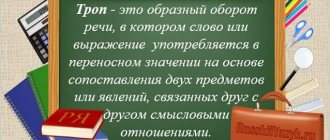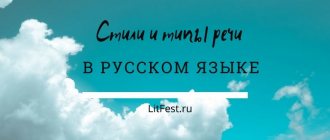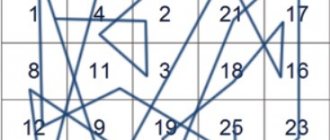Updated July 23, 2021 Author: Dmitry Ivanetscu
Hello, dear readers of the KtoNaNovenkogo.ru blog. Today we will talk about such a term as TRAILS, which are actively used in literature.
Although in our everyday speech we constantly use these techniques without even knowing it.
For example, when we praise our father’s golden hands, we are afraid to buy a pig in a poke, or we say that we waited half a day, although in fact only fifteen minutes have passed.
What are means of artistic expression?
The term “paths” comes from the Greek word tropos, which translated into Russian means “turn of speech.” They are used to give figurative speech; with their help, poetic and prose works become incredibly expressive. Tropes in literature, examples of which can be found in almost any poem or story, constitute a separate layer in modern philological science. Depending on the situation of use, they are divided into lexical means, rhetorical and syntactic figures. Tropes are widespread not only in fiction, but also in oratory, and even everyday speech.
Lexical means of the Russian language
Every day we use words that in one way or another decorate our speech and make it more expressive. Vivid tropes, examples of which are countless in works of art, are no less important than lexical means.
- Antonyms are words that have opposite meanings.
- Synonyms are lexical units that are close in meaning.
- Phraseologisms are stable combinations consisting of two or more lexical units, which in terms of semantics can be equated to one word.
- Dialectisms are words that are common only in a certain territory.
- Archaisms are outdated words denoting objects or phenomena, modern analogues of which are present in human culture and everyday life.
- Historicisms are terms denoting already disappeared objects or phenomena.
Visual and expressive means of language
Visual and expressive means also known as tropes, means of artistic representation, artistic methods
The trope is one of the main tools in a writer’s work. Everyone uses them, but sometimes not everyone knows that a certain ordinary expression is, for example, synecdoche. It's time to find out which trails you use most often!
Trope (from ancient Greek τρόπος - turnover) - words and expressions that are used - in a work of art in a figurative sense in order to enhance the imagery of language, the artistic expressiveness of speech.
Absolutely all authors use tropes; perhaps there is not a single writer who does without tropes, for even our everyday life and habitual colloquial speech is replete with them.
True, there are authors who consciously refuse to embellish the text, striving for brevity of speech and transparency of thought. Our contemporary Bernard Werber can definitely be included among them.
In the rich literary world there are also its antagonists, whose texts are replete with tropes and other stylistic tricks: Oscar Wilde, the prose of Marina Tsvetaeva, Tatyana Tolstaya.
But this is already a question about the individual author’s style: both will have fans, and there will also be critics who will both forgive the excessive lapidary nature of the text and against its excessive saturation with tropes.
Probably, the truth is somewhere in the middle, although we sincerely support the idea that you need to write the way you want, without being guided by any laws, rules, and, especially, the opinions of critics.
What we need to fight, in our opinion, is illiteracy and ignorance. So let's explore the trails.
However, it must be borne in mind that knowledge of the names of tropes will not greatly help the author to create a cunning turn of phrase, and, nevertheless, it would not be a bad idea for a decent writer to understand both the theory of literature in general, and what a metaphor is and what it does different from metonymy.
Main types of trails:
Epithet
An epithet (from the ancient Greek ἐπίθετον - “attached”) is a definition attached to a noun, affecting its expressiveness. It is expressed mainly by an adjective, but also by an adverb (“to love passionately”), a noun (“the noise of fun”), a numeral (second life), and less often by a verb (“the desire to forget”).
The epithet acquires some new meaning or semantic connotation, helps the word (expression) gain color and richness.
An epithet is a figurative definition that expresses the author’s emotional attitude towards the object of the image.
Example: Silver gray hair, emerald forest, golden sun.
Metaphor
Metaphor (from the ancient Greek μεταφορά - “transfer”, “figurative meaning”) is a trope that uses the name of one object to describe another object, transferring meaning from one to another. The basis of the metaphor is the transfer of properties of one object to another .
We are surrounded by a huge number of everyday metaphors: the knives of a chair or table, the neck of a bottle, the back of a chair.
Tables and chairs do not have legs, but their support is so similar to human legs that we have given them the diminutive name “legs.”
The bottle does not have a neck, but we call it that by analogy with the long human neck, the neck. The “back of a chair” metaphor is based on the idea of its similarity to a person’s straight back.
And this can continue ad infinitum: the sun is setting, the sea is raging, the wind is whistling.
A metaphor can easily be formed from the epithet: silver gray hair - silver gray hair, emerald forest - emerald forest, golden sun - gold of the sun.
Metaphor can easily be called the most favorite trope of most authors. Metaphorism in general lies at the heart of writing. Therefore, it makes sense to spend time studying metaphor, as well as its varieties: metonymy and synecdoche.
Metonymy (from the ancient Greek μετονυμία - “renaming”, from μετά - “above” and ὄνομα/ὄνυμα - “name”) is a phrase in which one word is replaced by another, denoting an object or phenomenon that is in one way or another connected with the object that is indicated by the word being replaced. The connection between words can be quantitative, spatial, temporal, etc. The replacement word is used in a figurative meaning.
If metaphor is a transfer by similarity, then metonymy is a transfer by “contiguity”. Metonymy identifies a property in an object, object or phenomenon that, by its nature, can replace all others. It could be:
Synecdoche (from the ancient Greek συνεκδοχή) is a type of metonymy based on the transfer of meaning from one phenomenon to another based on the quantitative relationship between them: “I’m still eager to become a writer ” (here the plural is used instead of the singular), “ the buyer is demanding” (in this in the opposite example - the singular replaces the plural), “I’ll warm myself up in my corner ” (the word “corner” is used in the meaning of “home” - that is, a part instead of the whole),
Hyperbola
Hyperbole (from the ancient Greek ὑπερβολή “transition; excess, excess; exaggeration”) is a stylistic figure of obvious and deliberate exaggeration, in order to enhance expressiveness and emphasize the said thought, for example, “I told you about this a hundred thousand times” or “yes there and beyond.” You won’t get there for three years.”
Hyperbole is an exaggeration. Exaggeration can be expressed in one word (love in Mayakovsky) and a phrase or phrase (“The darkness of the night is pointed at me / A thousand binoculars on the axis”).
Litotes
Litota (from the ancient Greek λιτότης - simplicity, smallness, moderation) is a figurative and expressive means that has the meaning of understatement or softening. For example: “An elephant is the size of a cat.”
Litota is an understatement. Just like hyperbole, it can be expressed in one word (Mayakovsky’s lyubenok) and an entire phrase (“A person’s life is one moment”).
Comparison
Comparison is a trope in which one object or phenomenon is compared to another according to some characteristic common to them.
Comparison, it would seem, is the simplest type of tropes, and identifying it, at first glance, is quite simple; in addition to the usual comparison, which is based on a comparative phrase, there are more sophisticated, complex types of comparisons, which are sometimes confused with metaphors.
Tropes in Russian (examples)
Currently, the means of artistic expression are magnificently demonstrated in the works of classics. Most often these are poems, ballads, poems, sometimes stories and tales. They decorate speech and give it imagery.
- Metonymy is the replacement of one word by another by contiguity. For example: On New Year's midnight the whole street came out to set off fireworks.
- An epithet is a figurative definition that gives an object an additional characteristic. For example: Mashenka had magnificent silk curls.
- Synecdoche is the name of a part instead of the whole. For example: A Russian, a Finn, an Englishman, and a Tatar are studying at the Faculty of International Relations.
- Personification is the assignment of animate qualities to an inanimate object or phenomenon. For example: The weather was worried, angry, raging, and a minute later it began to rain.
- Comparison is an expression based on the comparison of two objects. For example: Your face is fragrant and pale, like a spring flower.
- Metaphor is the transfer of the properties of one object to another. For example: Our mother has golden hands.
Tropes in literature (examples)
The presented means of artistic expression are less often used in the speech of modern people, but this does not diminish their importance in the literary heritage of great writers and poets. Thus, litotes and hyperbole are often used in satirical stories, and allegory in fables. Periphrasis is used to avoid repetition in a literary text or speech.
- Litotes is an artistic understatement. For example: A little man works in our factory.
- Periphrasis is the replacement of a direct name with a descriptive expression. For example: The night star is especially yellow today (about the Moon).
- Allegory is the depiction of abstract objects with images. For example: Human qualities - cunning, cowardice, clumsiness - are revealed in the form of a fox, a hare, a bear.
- Hyperbole is a deliberate exaggeration. For example: My friend has incredibly huge ears, the size of his head.
What is a metaphor and how to use it?
The metaphor literally translates as “transfer.” (from ancient Greek μεταφορά - “transfer”, “figurative meaning”)
Thanks to metaphor, the text becomes alive and juicy.
Metaphor is a comparison by characteristic. For example, by color (the Moon is cheese in the sky), by the quality of taste, by the similarity of feelings. A lonely sail turns white. (a lonely sail and one person are also lonely)
Using metaphor in copywriting
For example, we will sell a course for HR directors “Do you want to have a lot of free time to develop yourself and your business. Then…". In this example, the "Free Time Wagon" is a metaphor.
Here are more examples:
- Faithful helper, kind dog
- Round dance of clients
- A swarm of musicians
But unlike literary texts, in business texts such options will work worse, since the beauty of the syllable is not valued here. And it's more like a mockery.
Rhetorical figures
The idea of every writer is to intrigue his reader and not demand an answer to the problem posed. A similar effect is achieved through the use of rhetorical questions, exclamations, appeals, and omissions in a work of art. All these are tropes and figures of speech, examples of which are probably familiar to every person. Their use in everyday speech is encouraged, the main thing is to know the situation when it is appropriate.
A rhetorical question is posed at the end of a sentence and does not require an answer from the reader. It makes you think about pressing issues.
The incentive sentence ends with a rhetorical exclamation. Using this figure, the writer calls for action. The exclamation should also be classified under the “paths” section.
Examples of rhetorical appeal can be found in Pushkin (“To Chaadaev”, “To the Sea”), in Lermontov (“The Death of a Poet”), as well as in many other classics. It applies not to a specific person, but to an entire generation or era as a whole. Using it in a work of art, a writer can blame or, on the contrary, approve of actions.
Rhetorical silence is actively used in lyrical digressions. The writer does not express his thoughts to the end and gives rise to subsequent reasoning.
Synecdoche
Synecdoche is an artistic trope that is created by transferring the name of an object from its part to the whole and vice versa.
All flags will be visiting us. (A.S. Pushkin) In this context, flags (part) mean countries (whole) that will establish ties with Russia. We read from N.V. Gogol in the novel Dead Souls: “Hey, beard! How do you get from here to Plyushkin?” The writer called the man a beard because of one characteristic feature in his appearance. And before the reader a visible image of this man with a thick beard appeared. This is an artistic trope - synecdoche.
In Charles Perrault's fairy tale, a little girl is named Little Red Riding Hood because of one headdress that stands out in her outfit - a red cap that her mother gave her for her birthday.
- The old red head with sideburns appeared again from behind the door, looked and entered the office along with its rather ugly body. (I.S. Turgenev)
- Only the constricted back of his head, sighing noisily, whispered. (A.M. Gorky) Synecdoche can occur when the singular number of a noun is used as a plural.
- And you could hear the Frenchman rejoicing until dawn. (M.Yu. Lermontov)
- Swede, Russian stabs, chops, cuts. (A.S. Pushkin)
Syntactic figures
Such techniques are achieved through sentence construction and include word order, punctuation; they make for an intriguing and interesting sentence design, which is why every writer strives to use these tropes. Examples are especially noticeable when reading the work.
- Polyunion is a deliberate increase in the number of unions in a sentence.
- Non-union - the absence of unions when listing objects, actions or phenomena.
- Syntactic parallelism is a comparison of two phenomena by depicting them in parallel.
- Ellipsis is the deliberate omission of a number of words in a sentence.
- Inversion is a violation of the word order in a construction.
- Parcellation is the deliberate division of a sentence.
Figures of speech
The paths in the Russian language, examples of which are given above, can be continued endlessly, but we should not forget that there is another conventionally distinguished section of means of expression. Artistic figures play an important role in written and oral speech.
- Anaphora - repetition of the initial sections of speech.
- Epiphora – repetition of final segments of speech.
- Gradation is a gradual and continually increasing ascension from one thought to another.
- A pun is the use of identical sounding words with different meanings in one sentence.
- Antithesis is a sharp opposition.
- An oxymoron is a combination of words with opposite meanings.
We enrich the language with figurative and expressive means
Fine and expressive means of language allow not only to convey information, but also to clearly and convincingly convey thoughts. Lexical means of expression make the Russian language emotional and colorful.
Expressive stylistic means are used when an emotional impact on listeners or readers is necessary. It is impossible to make a presentation of yourself, a product, or a company without using special language tools.
Lexical means of expression
The word is the basis of visual expressiveness of speech. Many words are often used not only in their direct lexical meaning. The characteristics of animals are transferred to the description of a person’s appearance or behavior - clumsy like a bear, cowardly like a hare. Polysemy (polysemy) is the use of a word in different meanings.
Homonyms are a group of words in the Russian language that have the same sound, but at the same time carry different semantic loads, and serve to create a sound game in speech.
Puns are used to give speech a humorous, satirical meaning; they convey sarcasm well. They are based on the sound similarity of words or their polysemy.
Synonyms - describe the same concept from different sides, have different semantic load and stylistic coloring. Without synonyms it is impossible to construct a bright and figurative phrase; speech will be oversaturated with tautology.
Antonyms are words that have opposite lexical meanings and refer to the same part of speech. Allows you to create bright and expressive phrases.
Trails
Tropes are words in Russian that are used in a figurative sense. They give speech and works imagery, expressiveness, are designed to convey emotions, and vividly recreate the picture.
Defining Tropes
| Allegory | Allegorical words and expressions that convey the essence and main features of a particular image. Often used in fables. |
| Hyperbola | Artistic exaggeration. Allows you to vividly describe properties, events, signs. |
| Grotesque | The technique is used to satirically describe the vices of society. |
| Irony | Tropes that are designed to hide the true meaning of an expression through slight ridicule. |
| Litotes | The opposite of hyperbole is that the properties and qualities of an object are deliberately understated. |
| Personification | A technique in which inanimate objects are attributed the qualities of living beings. |
| Oxymoron | Connection of incompatible concepts in one sentence (dead souls). |
| Periphrase | Description of the item. A person, an event without an exact name. |
| Synecdoche | Description of the whole through the part. The image of a person is recreated by describing clothes and appearance. |
| Comparison | The difference from metaphor is that there is both what is being compared and what is being compared with. In comparison there are often conjunctions - as if. |
| Epithet | The most common figurative definition. Adjectives are not always used for epithets. |
Metaphor is a hidden comparison, the use of nouns and verbs in a figurative meaning. There is always no subject of comparison, but there is something with which it is compared.
There are short and extended metaphors. Metaphor is aimed at external comparison of objects or phenomena.
Metonymy is a hidden comparison of objects based on internal similarity. This distinguishes this trope from a metaphor.
Syntactic means of expression
Stylistic (rhetorical) - figures of speech are designed to enhance the expressiveness of speech and artistic works.
Types of stylistic figures
| Name of syntactic structure | Description |
| Anaphora | Using the same syntactic constructions at the beginning of adjacent sentences. Allows you to logically highlight a part of the text or a sentence. |
| Epiphora | Using the same words and expressions at the end of adjacent sentences. Such figures of speech add emotionality to the text and allow you to clearly convey intonation. |
| Parallelism | Constructing adjacent sentences in the same form. Often used to enhance a rhetorical exclamation or question. |
| Ellipsis | Deliberate exclusion of an implied member of a sentence. Makes speech more lively. |
| Gradation | Each subsequent word in a sentence reinforces the meaning of the previous one. |
| Inversion | The arrangement of words in a sentence is not in direct order. This technique allows you to enhance the expressiveness of speech. Give the phrase a new meaning. |
| Default | Deliberate understatement in the text. Designed to awaken deep feelings and thoughts in the reader. |
| Rhetorical appeal | An emphatic reference to a person or inanimate objects. |
| A rhetorical question | A question that does not imply an answer, its task is to attract the attention of the reader or listener. |
| Rhetorical exclamation | Special figures of speech to convey expression and tension of speech. They make the text emotional. Attract the attention of the reader or listener. |
| Multi-Union | Repeated repetition of the same conjunctions to enhance the expressiveness of speech. |
| Asyndeton | Intentional omission of conjunctions. This technique gives the speech dynamism. |
| Antithesis | A sharp contrast of images and concepts. The technique is used to create contrast; it expresses the author’s attitude towards the event being described. |
Tropes, figures of speech, stylistic means of expression, and phraseological statements make speech convincing and vivid.
Such phrases are indispensable in public speeches, election campaigns, rallies, and presentations. In scientific publications and official business speech, such means are inappropriate - accuracy and persuasiveness in these cases are more important than emotions.
Table of all tropes with examples
It is important for high school students, graduates of humanities faculties and philologists to know the variety of means of artistic expression and cases of their use in the works of classics and contemporaries. If you want to know in more detail what types of tropes there are, a table with examples will replace dozens of literary critical articles.
| Lexical means and examples | |
| Synonyms | We may be humiliated and insulted, but we deserve a better life. |
| Antonyms | My life is nothing but black and white stripes. |
| Phraseologisms | Before buying jeans, find out about their quality, otherwise they will give you a pig in a poke. |
| Archaisms | Barbers (hairdressers) do their job quickly and efficiently. |
| Historicisms | Bast shoes are an original and necessary thing, but not everyone has them today. |
| Dialectisms | There were roes (snakes) in this area. |
| Stylistic tropes (examples) | |
| Metaphor | You have nerves of iron, my friend. |
| Personification | The foliage sways and dances with the wind. |
| Epithet | The red sun sets below the horizon. |
| Metonymy | I've already eaten three plates. |
| Synecdoche | The consumer always chooses quality products. |
| Periphrase | Let's go to the zoo to see the king of beasts (about a lion). |
| Allegory | You are a real ass (about stupidity). |
| Hyperbola | I've been waiting for you for three hours already! |
| Litotes | Is this a man? A little guy, and that's all! |
| Syntactic figures (examples) | |
| Anaphora | How many are there with whom I can be sad, How few are those with whom I can love. |
| Epiphora | We'll go through the raspberries! Do you like raspberries? No? Tell Danil that we’ll go through the raspberries. |
| Gradation | I think about you, I miss you, I remember, I miss you, I pray. |
| Pun | Because of you, I began to drown my sadness in wine. |
| Rhetorical figures (appeal, exclamation, question, silence) | When will you, the younger generation, become polite? Oh, what a wonderful day it is today! And you say that you know the material perfectly? You'll come home soon - look... |
| Multi-Union | I know algebra, geometry, physics, chemistry, geography, and biology very well. |
| Asyndeton | The store sells shortbread, crumbly, peanut, oatmeal, honey, chocolate, diet, and banana cookies. |
| Ellipsis | Not so (it was)! |
| Inversion | I would like to tell you one story. |
| Antithesis | You are everything and nothing to me. |
| Oxymoron | Living Dead. |
Hyperbola
Hyperbole is an exaggeration (for example: a sea of tears, fast as lightning, we haven’t seen each other for a hundred years, I’m saying this for the hundredth time, etc.) rivers of blood, you’re always late, mountains of corpses, we haven’t seen each other for a hundred years, scare until death, I said a hundred times, a million apologies, a sea of ripened wheat, I’ve been waiting for an eternity, I stood all day, even if it’s flooded, the house is a thousand kilometers away, constantly late.
And the pine tree reaches the stars. (O. Mandelstam) In a dream, the janitor became heavy, like a chest of drawers. (I. Ilf and E. Petrov) Perhaps, admiring them, you gave him darkness of your qualities; he is not a sinner in anything, you are a hundred times more sinful. (A.S. Griboyedov) A rare bird will fly to the middle of the Dnieper. (N.V. Gogol) A decent person is ready to run away from you, far away. (F. Dostoevsky) A million torments (A.S. Griboyedov “Woe from Wit”).
The role of means of artistic expression
The use of tropes in everyday speech elevates every person, makes him more literate and educated. A variety of means of artistic expression can be found in any literary work, poetic or prosaic. Paths and figures, examples of which every self-respecting person should know and use, do not have an unambiguous classification, since from year to year philologists continue to study this area of the Russian language. If in the second half of the twentieth century they singled out only metaphor, metonymy and synecdoche, now the list has increased tenfold.








